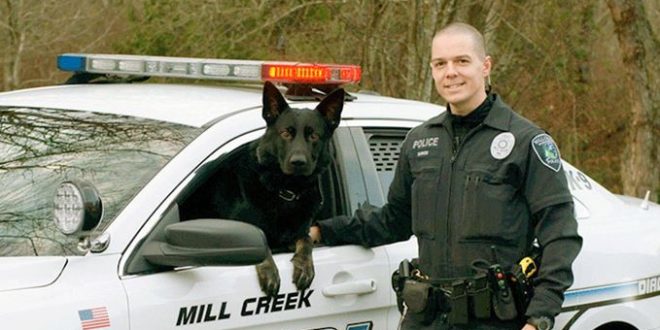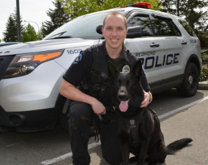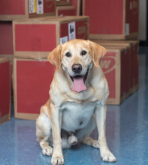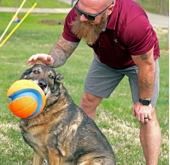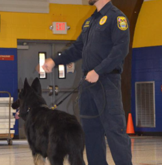Died – 5/6/18
Handler – Officer Ian Durkee
Mill Creek police dog dies after four years of service
The city’s police department is finding its footing after one of its own died Sunday. He leaves behind a lasting legacy and a leash. Rasko, Mill Creek’s trailblazing police service dog, was euthanized after health complications arose because of suspected tumors on his heart. Officer Ian Durkee, his handler, said he first noticed the dog’s elevated heart rate, breathing difficulties and distended abdomen in February. A veterinarian discovered fluid buildup around the dog’s heart. A trip to the Washington State University Veterinary Teaching Hospital in Pullman for surgery also found what looked like tumors on the heart, a sign of cancer. The dog was retired in March and put into Durkee’s ownership, almost a year earlier than originally planned before the medical evaluations. Durkee said the best estimate for Rasko’s remaining life was six months, and the dog spent his retired days at his home, playing catch and lounging in the grass. Rasko’s health deteriorated Sunday, when Durkee said a veterinarian told him Rasko was not getting enough oxygen. “It’s certainly really sad and tough to deal with, but we got that bit of extra time,” Durkee said. Rasko was the first service animal in the city’s history when he was commissioned in 2013. Over the years, the purebred German shepherd had 130 deployments and 32 arrests as a highly trained tracking dog. Mill Creek Police Chief Greg Elwin said the wet conditions of the area can make finding scents difficult. Factor in the time between when a suspect was last seen and a tracking dog arrives on scene, and the task is even more challenging. Police service dogs are expected to capture their targets about one-third of the time. “That’s a very good career,” Elwin said. “That’s a good amount of deployments. What gets lost in those numbers is what those deployments are.” As a tracking dog, Rasko looked for people and evidence, helped catch suspects, protected officers and took part in community outreach. In between those flashes of unleashed instinct and honed focus were a lot of little moments between a man and his dog. During downtime on evening patrols, they would train with commands and mock searches. Durkee would bring him into the police station to visit with the other two dozen officers and Elwin. The retirement transition was tough for Rasko, who mostly knew working life, Durkee said. When he would go to his car, Rasko would be right there, ready for the ride and patrol. Since 2013, the two were nearly inseparable. “Maximum a week, if it was vacation where I had to go by myself and he couldn’t go with me,” Durkee said of their rare time apart. “But there was almost constant interaction going on.” At home with Durkee and his wife, Rasko was a loyal companion. They would play with a ball or favorite toy — a jealously guarded and well-chewed Kong. That is, unless Rasko wanted you to play. “He was pretty protective of his toy, he wouldn’t want you to come take it or throw it,” Durkee said. “But he would put it on an edge or a ledge, and he would shove it off the edge and look at you like, ‘Are you going to pick it up and throw it now?’ ” Although Rasko was the city’s property and Durkee’s partner, the dog was not really a pet. Rasko wasn’t interested in playing with other dogs and needed to be in the right environment to let his guard down, Durkee said. One way Durkee knew Rasko was comfortable with other people was if he’d expose his belly for some scratching and petting. “But he didn’t show it often,” he said. Rasko came into the picture early in the process of the city launching its police dog team. Durkee initially offered his personal dog for training, but that didn’t pan out. With a limited window to stay in the program and no funds available for another dog, Mill Creek resident Roy Cats donated $10,000 to buy a police service dog. Durkee tried another dog, but that didn’t work either. He was able to trade with the kennel for Rasko, which proved to be the right pairing. “There’s a deep, deep, deep connection between a handler and his partner,” Chief Elwin said. “They play together, they fight together, they sweat together. It’s a very close relationship.” Becoming a dog handler in law enforcement was the realization of a childhood dream for Durkee. As a teenager in Gresham, Oregon, he was part of the police department’s Explorer program, “washing the cars,” and going on ride-alongs. Durkee said he got a clear picture of the career, which further cemented his ambition to join the ranks. Durkee isn’t sure if he’ll be the next handler. He said he would like to give another officer an opportunity like he had with Rasko. Mill Creek expanded to a second police dog team with Officer Nathan Lerma and Bagira, a German shepherd. Doing so was expensive, estimated at about $25,000 for the dog, training and equipment. The second police dog was funded mostly through seized illicit and drug money and forfeited funds from drug cases. Using such funds is common practice for police departments. Bagira, like Rasko, has training in tracking. The suburban city, with a population of about 20,000 people, plans to get the dog trained in drug detection as well. “Our needs have changed, society has changed, the city has grown,” Elwin said. The police department’s plan was to have two teams, one for the day shift and another for evenings. Elwin said he will try to budget for a second police dog in the coming year. Mill Creek has a police dog program “because an Durkee took it upon himself to say, ‘The city could really benefit from this … ’ ” Elwin said. “It was his initiative. He got this whole thing going.”
